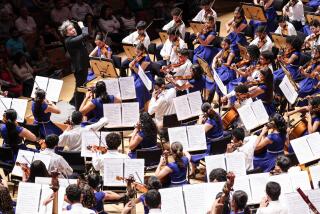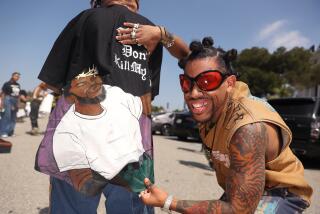MANDELA’S VISIT TO L.A. : Youngsters Find Rare Chance to See a Real Hero : Mandela: Students find several ways to share in anti-apartheid leader’s stay in L.A. To some, he’s a king; to others, a hope for a better future.
For many of the children of Los Angeles, these are times of guns in the classroom, of gangs, drugs and disillusionment. A time of too few heroes. That was why Harold Love was so excited Friday after seeing Nelson Mandela at City Hall.
“You sort of felt like you were in medieval times, seeing a king,” said Love, who at 15 was born too late to know Martin Luther King Jr., and other civil rights giants as anything other than history book figures. “In a way, he is: A king for his people.”
While Mandela came to Los Angeles principally to meet with its movers and shakers, moguls and movie stars, there were many in his audience who believed his most important accomplishment was simply to stand before the city’s troubled youngsters as a real-life hero.
Specific visits with youngsters were not on Mandela’s Los Angeles schedule, but plans had been made to ensure they had opportunities to hear his message. Community groups ferried gang members by bus to his speech at the L.A. Coliseum. Schoolteachers took their young charges to City Hall. And students organized a march on Martin Luther King Jr. Boulevard to welcome Mandela.
“I want to learn, is he true?” said 14-year-old Donte, who lives in a Crenshaw District home for minors on probation. “Can he help me? Can I look up to him?”
Friday afternoon, hundreds of students from throughout Southern California could be seen walking to the Coliseum from Rancho Cienega Park in Southwest Los Angeles carrying banners and chanting slogans to the beat of an African drum troop.
“He has the strongest soul of any world leader,” said Jacob Pinger, 19, a member of the Los Angeles Student Coalition, which organized the nearly four-mile youth march along with black, Asian and Latino student organizations throughout Los Angeles. “Kids are sick of seeing people elected and then selling out as as soon as (the) people forget their promises.
“Mandela,” he said, “is a leader that doesn’t sell out.”
Motorists honked horns and saluted the marchers with upraised fists as they moved slowly through the Crenshaw District.
Throughout South Los Angeles and other parts of the city, parents and teachers had spent the last few weeks teaching their children about Mandela, to make sure his message of hope and dignity was not lost.
At Marcus Garvey School, where black history is as much an educational staple as reading and arithmetic, a little girl with auburn-colored corn rows had said earlier in the week that she hoped Mandela would bring her a miracle.
“I want Mandela to tell us people shouldn’t be in gangs,” said 11-year-old Amber Mason, “that they are killing up their own people. I hope Mandela would change (it), that he’ll make a difference.”
Mandela holds a special significance for many black children, who grew up on stories of Selma and Montgomery, bus boycotts and freedom marches, but who were born too late to experience them.
“Most of them weren’t around when King was living, so (they) don’t understand the significance of King and Malcolm X,” said Louis Sheppard, a co-founder of a manhood training program for young black men, who brought 42 students to see Mandela speak at City Hall.
“I believe by hearing Mandela they’ll get a more international perspective and realize that African-Americans are not an isolated people. They’re getting to see the problems affecting Africans all over the world.”
Sheppard, a history teacher at Palomar Junior High in Pomona, added: “By being here, they’ll see the closest thing they’re ever going to see to Martin Luther King Jr. Twenty years from now, when their kids are talking about Mandela, they’ll be able to say, ‘Oh yeah, I remember when.’ And it’ll make a difference.”
But Mandela’s message can transcend color. Young Mi Suh, a 19-year-old Korean-American, said that Mandela is also her hero. Like King, she said, his fight is for all victims of racism. “And that includes me. That includes the color yellow.”
She has read much about battles against oppression; of the civil rights movement in America and of her own parents’ struggles against the Japanese occupation of their homeland. But history, she said, means little until you feel it for yourself.
“All the great things you hear (about) you have to make personal before it means something to you,” said Suh.
Not all youngsters were as convinced. Some said bluntly that they saw no connection between South-Central and South Africa. They felt they would find little inspiration in the words of an elderly man who lived half a world away.
A few did not even know who Mandela was.
“I thought he was a rapper,” admitted Marcus, a former gang member, who first heard Mandela’s name on a rap-oriented radio station last week. “They were saying ‘Nelson Mandela will visit’ and I said, ‘Who is this guy? He must be somebody.’ ”
Marcus, a short, stocky 16-year-old, was one of six teen-agers in a Crenshaw District group home being taken to hear Mandela’s speech at the Coliseum. Officials did not want to his last name published because he is on probation.
Marcus said he didn’t believe in heroes. Marcus said he believed a long time ago, when he thought supermen could leap buildings in a single bound. But they couldn’t help him get a job, or give him an alternative to gang life. So he dropped them.
“Now,” he said, “I’m my own hero.”
Times staff writer Darrell Dawsey contributed to this report.
RELATED STORIES, PICTURES: B3,B4
More to Read
Sign up for Essential California
The most important California stories and recommendations in your inbox every morning.
You may occasionally receive promotional content from the Los Angeles Times.









